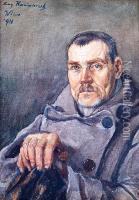Eugeniusz Marcin Kazimirowski Paintings
Eugeniusz Marcin Kazimirowski was born on December 11, 1873, in the village of Berezwecz, now in modern-day Belarus, which at the time was part of the Russian Empire. He was a Polish painter known for his contributions to both religious and secular art, but he is most renowned for his significant role in the Divine Mercy movement. Kazimirowski's artistic journey began at the Imperial Academy of Arts in Saint Petersburg, Russia, where he honed his skills and developed a foundation in classical art, which would later influence his religious works.
After completing his education, Kazimirowski engaged in various artistic endeavors, including teaching and participating in numerous exhibitions. His career took a pivotal turn when, in 1934, he was commissioned by Sister Faustina Kowalska, under the guidance of her spiritual director Blessed Michał Sopoćko, to paint the first image of the Divine Mercy. This commission was based on Sister Faustina's visions of Jesus Christ, in which she was instructed to have an image painted to represent Christ's divine mercy, with the inscription "Jezu, ufam Tobie" ("Jesus, I trust in You").
Kazimirowski's rendition of the Divine Mercy, completed in Vilnius in 1934, became the first visual representation of Sister Faustina's visions, setting a precedent for one of the most iconic religious images in the 20th century. Despite the significance of this work, Kazimirowski himself remained relatively obscure in the broader context of art history, with the Divine Mercy image often overshadowing his other contributions to the art world.
Throughout his life, Kazimirowski was involved in various artistic projects, including landscape painting and portraiture, showcasing his versatility as an artist. His style was influenced by the realism and academic art of his education, but also reflected a personal interpretation that gave his works a unique character.
Eugeniusz Marcin Kazimirowski passed away on September 23, 1939, in Białystok, Poland, just as World War II was beginning to engulf Europe. While he is not as widely recognized as other artists of his time, his creation of the original Divine Mercy painting remains a testament to his artistic skill and a lasting legacy of his contribution to religious art. Kazimirowski's life and work continue to be celebrated in the context of the Divine Mercy devotion, ensuring his place in the annals of religious art history.



